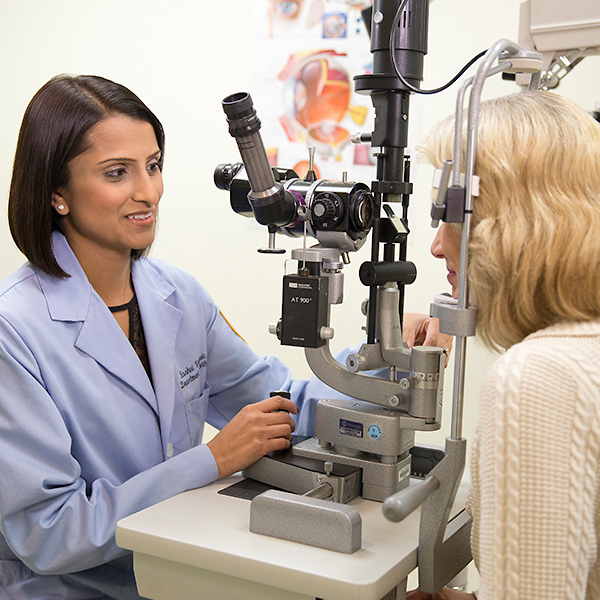Contact Lenses
Overview and Facts about Contact Lenses
The contact lens service at Loyola’s department of ophthalmology has experienced optometrists using the latest technology to ensure you have lenses appropriate for your eyes to avoid complications and provide clear vision for years of safe, comfortable wear.
The first step before obtaining contact lenses is a comprehensive eye examination to evaluate the overall health of your eyes. Next, the contact lens fitting will include all of the following:
- Evaluation of contact lenses for proper fit, vision and comfort
- Training on proper insertion and removal of the lenses
- Instruction on the proper care of your lenses
- Follow-up care to evaluate for complications
Adhering to the instructions you receive about wearing time, replacement schedules and care of the lenses is crucial to problem-free contact lens wear.
Conditions Related to Contact Lenses
The majority of contact lenses are fit to address problems with refractive error – myopia, hyperopia, astigmatism and presbyopia. These conditions can also be uncovered during a comprehensive eye exam and include:
- Keratoconus
- Post corneal transplant
- Corneal scarring
- Severe dry eye
- Aphakia
- Prosthetic contact lenses to address disfigurement
Diagnostic Techniques Related to Contact Lenses
Refractive error conditions are uncovered during a routine comprehensive eye exam with a test called refraction, or a vision test.
To conduct a vision test, your doctor will shine a light into your eyes or use a computer to measure the amount of light reflected by your retina. This helps your doctor assess how light bends as it moves through your eyes.
To determine what kind of prescription you need, your doctor will ask you to read aloud the smallest row of letters you can see on an eye chart through a machine called a Phoropter.
By changing the lenses on this machine as you identify the letters, your doctor can find the right lenses that come closest to approximating 20/20 vision.
Procedures Offered
Depending on which type of contact lenses work best for you, your doctor may recommend soft, gas permeable or other specialty lenses.
Risks and Guidelines for Use of Contact Lenses
Contact lenses are safe and effective and when worn properly, offering years of problem-free, quality vision. However, because they interact with the living tissue of the eye, complications can arise. The most serious of these is infection.
Eye discomfort or pain, redness, blurred vision, and light sensitivity that persist after contact lenses are removed are warning signs of a problem that requires immediate attention.
The following guidelines are recommended for all contact lens wearers:
- Always wash, rinse and dry your hands before handling contact lenses.
- Inspect contact lenses prior to insertion for damage. Follow the wearing schedule recommended by your eye doctor and replace contact lenses at the interval recommended.
- Only use contact lens products and solutions recommended by your eye doctor.
- Clean and disinfect lenses properly following all labeling instructions provided with the lens care products. Rub and rinse contact lenses as recommended by your eye doctor.
- Change solution in the case daily - do not “top-off” or re-use solution. Clean, rinse and air-dry your lens case each time lenses are removed.
- Do not use expired contact lens solutions or those beyond their discard date.
- Do not substitute sterile saline solution for multipurpose solutions which are used for cleaning and disinfecting contact lenses. Sterile saline is for rinsing only. Never use non-sterile water with contact lenses (i.e., tap, distilled or homemade saline).
- Do not expose contact lenses or the case to any water: tap, bottled, distilled, lake or ocean water.
- Do not put contact lenses in your mouth to wet them.
- Replace your contact lens storage case every three months.
- Do not transfer contact lens solutions into smaller travel size containers. This can change the sterility of the solution and cause confusion using unlabeled containers.
- Remove lenses immediately and consult your eye doctor if irritation, redness, tearing or vision changes are noted.

Request an Appointment
Whether you are seeking routine eye care or have a specific vision issue, our team treats a wide range of eye diseases and conditions, including cataracts, glaucoma, macular degeneration and strabismus. Schedule an appointment today.
Schedule a Telehealth Appointment
